Abstract
Purpose
The purpose of this study was to evaluate whether the internal abutment length affected screw stability in an internal connection implant.
Materials and methods
Twenty long internal connection implants (Replus system, 4.7 × 11.5 mm) were selected for this investigation. Abutments were assigned to four groups depending on the length of the internal connection (abutments with internal lengths of 1, 2, 3, and 4 mm, respectively). Each implant fixture specimen was embedded in resin medium and connected to an abutment with an abutment screw. A load of 100 N, applied at an angle of 30° to the long axis of the implant, was repeated for 1.0 × 106 cycles. Reverse torque values (RTV) were recorded before and after loading, and the change in RTV was calculated. Data were analyzed with the Kruskal-Wallis test.
REFERENCES
1.Goodacre CJ., Kan JY., Rungcharassaeng K. Clinical complications of osseointegrated implants. J Prosthet Dent. 1999. 81:537–52.

2.Pjetursson BE., Brägger U., Lang NP., Zwahlen M. Comparison of survival and complication rates of tooth-supported fixed dental prostheses (FDPs) and implant-supported FDPs and single crowns (SCs). Clin Oral Implants Res. 2007. 18:97–113.

3.Jemt T., Laney WR., Harris D., Henry PJ., Krogh PH Jr., Polizzi G., Zarb GA., Herrmann I. Osseointegrated implants for single tooth replacement: a 1-year report from a multicenter prospective study. Int J Oral Maxillofac Implants. 1991. 6:29–36.
4.Becker W., Becker BE. Replacement of maxillary and mandibular molars with single endosseous implant restorations: a retrospective study. J Prosthet Dent. 1995. 74:51–5.

5.McGlumphy EA., Mendel DA., Holloway JA. Implant screw mechanics. Dent Clin North Am. 1998. 42:71–89.
6.Winkler S., Ring K., Ring JD., Boberick KG. Implant screw mechanics and the settling effect: overview. J Oral Implantol. 2003. 29:242–5.
7.Sakaguchi RL., Borgersen SE. Nonlinear contact analysis of preload in dental implant screws. Int J Oral Maxillofac Implants. 1995. 10:295–302.
8.Haack JE., Sakaguchi RL., Sun T., Coffey JP. Elongation and preload stress in dental implant abutment screws. Int J Oral Maxillofac Implants. 1995. 10:529–36.
9.Siamos G., Winkler S., Boberick KG. Relationship between implant preload and screw loosening on implant-supported prostheses. J Oral Implantol. 2002. 28:67–73.
10.Cavazos E., Bell FA. Preventing loosening of implant abutment screws. J Prosthet Dent. 1996. 75:566–9.

11.Aboyoussef H., Weiner S., Ehrenberg D. Effect of an antirotation resistance form on screw loosening for single implant-supported crowns. J Prosthet Dent. 2000. 83:450–5.

12.Binon PP. The spline implant: design, engineering, and evaluation. Int J Prosthodont. 1996. 9:419–33.
13.Wiskott HW., Jaquet R., Scherrer SS., Belser UC. Resistance of internal-connection implant connectors under rotational fatigue loading. Int J Oral Maxillofac Implants. 2007. 22:249–57.
14.Dixon DL., Breeding LC., Sadler JP., McKay ML. Comparison of screw loosening, rotation, and deflection among three implant designs. J Prosthet Dent. 1995. 74:270–8.

15.Ohrnell LO., Hirsch JM., Ericsson I., Brånemark PI. Single-tooth rehabilitation using osseointegration. A modified surgical and prosthodontic approach. Quintessence Int. 1988. 19:871–6.
16.Cibirka RM., Nelson SK., Lang BR., Rueggeberg FA. Examination of the implant-abutment interface after fatigue testing. J Prosthet Dent. 2001. 85:268–75.

17.Bambini F., Lo Muzio L., Procaccini M. Retrospective analysis of the influence of abutment structure design on the success of implant unit. A 3-year controlled follow-up study. Clin Oral Implants Res. 2001. 12:319–24.
18.McGlumphy EA., Robinson DM., Mendel DA. Implant superstructures: a comparison of ultimate failure force. Int J Oral Maxillofac Implants. 1992. 7:35–9.
19.Steinebrunner L., Wolfart S., Ludwig K., Kern M. Implant-abutment interface design affects fatigue and fracture strength of implants. Clin Oral Implants Res. 2008. 19:1276–84.

20.Khraisat A., Hashimoto A., Nomura S., Miyakawa O. Effect of lateral cyclic loading on abutment screw loosening of an external hexagon implant system. J Prosthet Dent. 2004. 91:326–34.

21.Wiskott HW., Nicholls JI., Belser UC. Stress fatigue: basic principles and prosthodontic implications. Int J Prosthodont. 1995. 8:105–16.
22.Tsuge T., Hagiwara Y. Influence of lateral-oblique cyclic loading on abutment screw loosening of internal and external hexagon implants. Dent Mater J. 2009. 28:373–81.

23.Gibbs CH., Mahan PE., Mauderli A., Lundeen HC., Walsh EK. Limits of human bite strength. J Prosthet Dent. 1986. 56:226–9.

Fig. 1.
Internal connection dental implant system. (A) From the left, abutments with internal lengths of 1, 2, 3, and 4 mm (a, b, c, and d, respectively); the abutment comprised double lobes, including an upper lobe and a lower lobe, (B) Longitudinal and cross sectional views of the implant fixture complex.
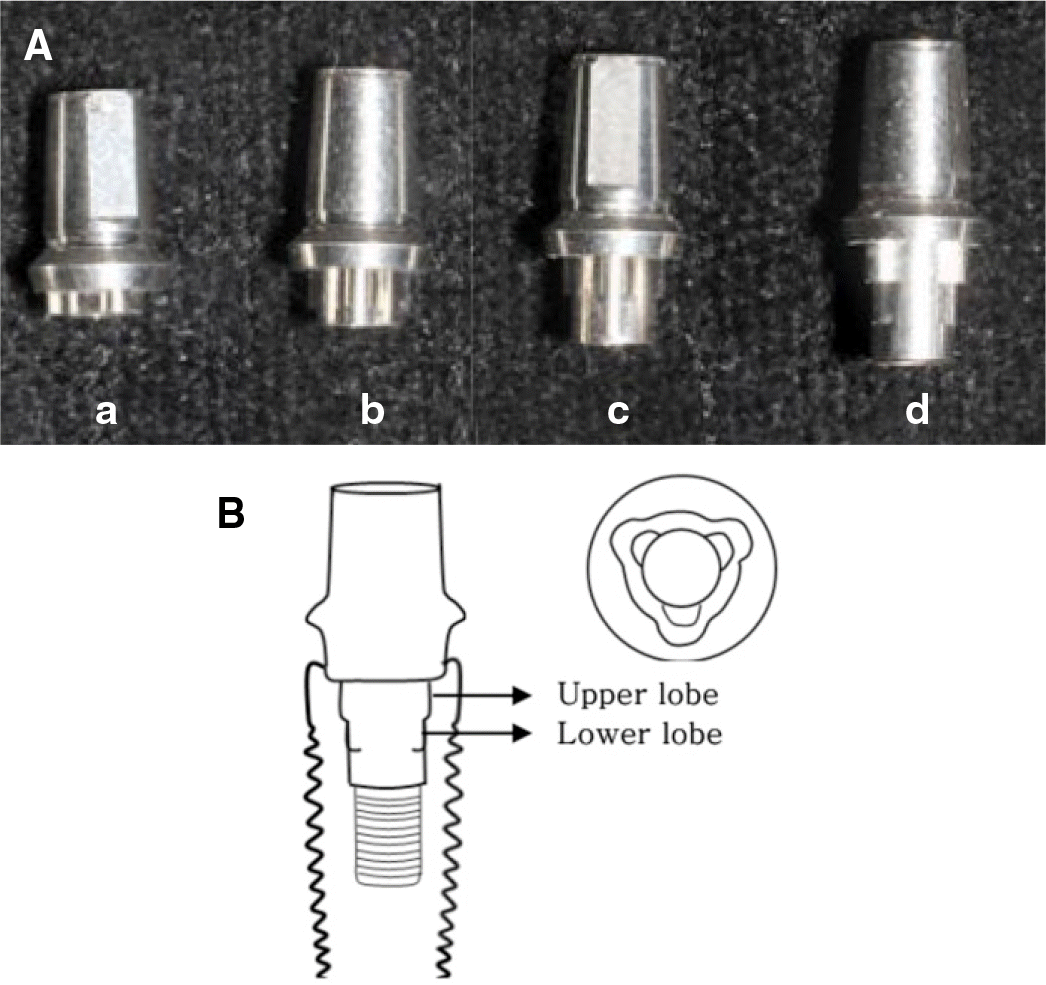
Fig. 2.
Implant crown fabrication. Crowns were cast with Ni-Cr; all crowns were of one size. A hole was made in the crown to measure the removal torque value of each specimen.
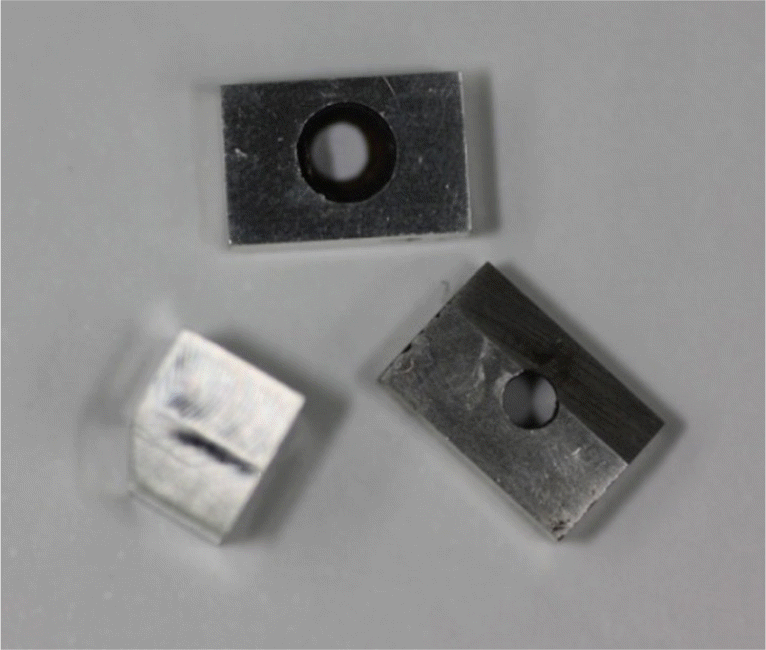
Fig. 3.
Crown refinement and fixation. (A) Schematic diagram of implant crown and loading direction (red arrows). (B) Schematic diagram of implant assembly embedded in clear resin. It was fixed at a 30° angle to the long axis of the implant.
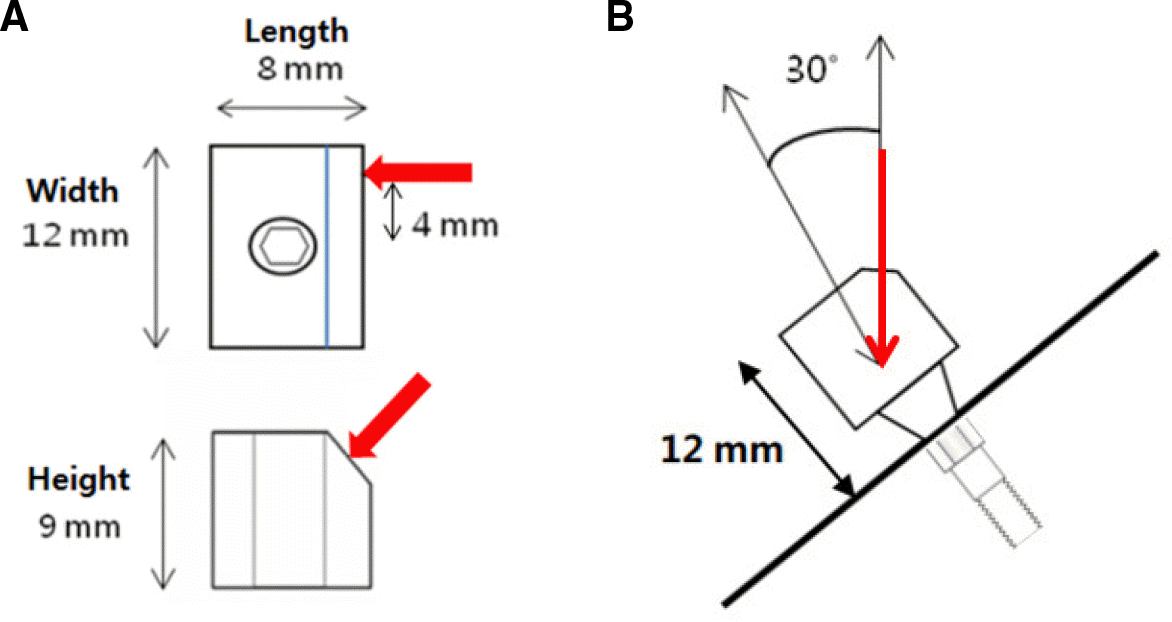
Fig. 4.
Means and standard deviations of the differences between initial and final RTVs. The groups represent different lengths of internal abutment connections (see Fig. 1A).
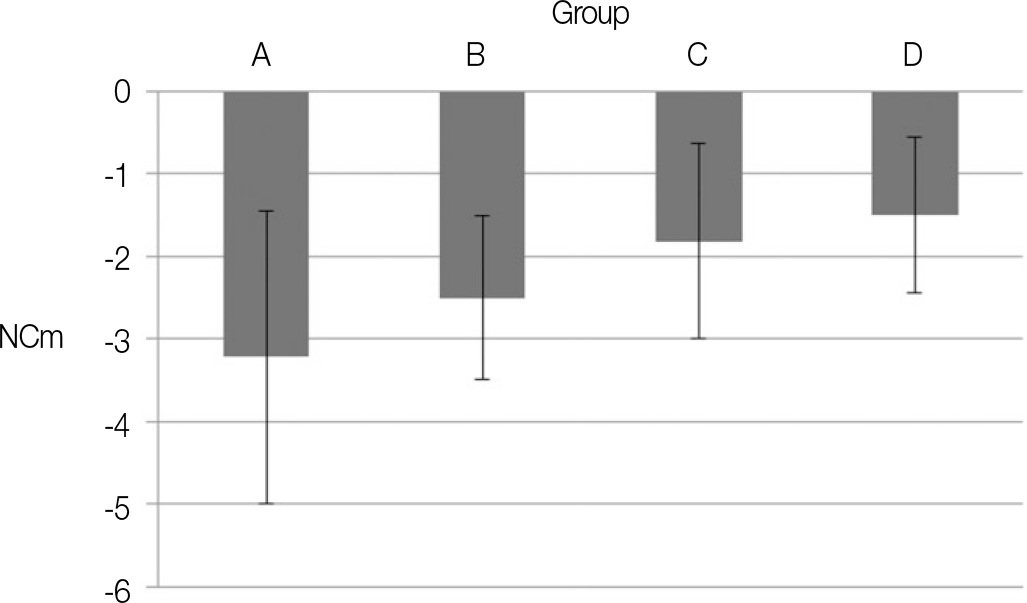
Fig. 5.
SEM images of abutment screw surfaces (×200 original magnification). (A) Ti alloy abutment screw into 1 mm internal abutment, (B) Ti alloy abutment screw into 2 mm internal abutment, (C) Ti alloy abutment screw into 3 mm internal abutment, (D) Ti alloy abutment screw into 4 mm internal abutment.
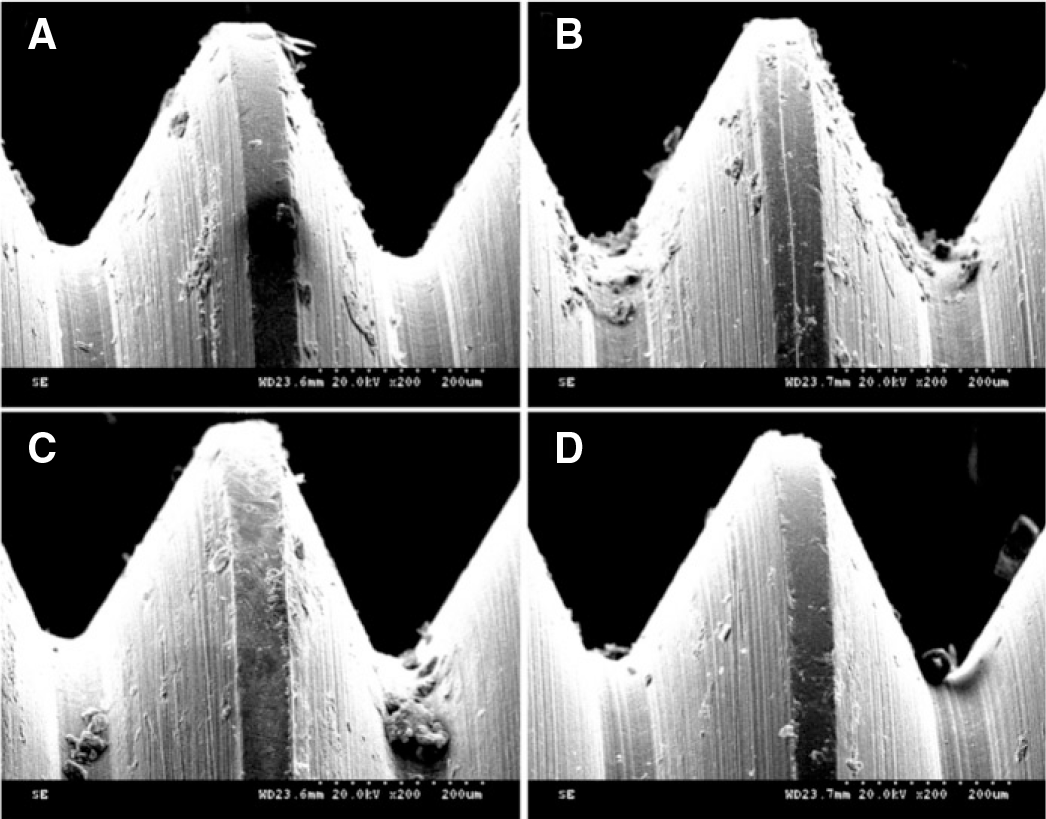
Fig. 6.
SEM images of internal abutment connection surfaces (×150 original magnification). (A) The lobe surface of a 1 mm internal abutment, no damage was observed; (B) upper lobe and lower lobe surfaces of a 2 mm internal abutment, upper lobe showed some damage, and the lower lobe showed significant damage and scratches; (C) lower lobe surface of a 3 mm internal abutment was more scratched than the upper lobe; (D) lower lobe surface of a 4 mm internal abutment showed significant scratch marks compared to other surfaces.
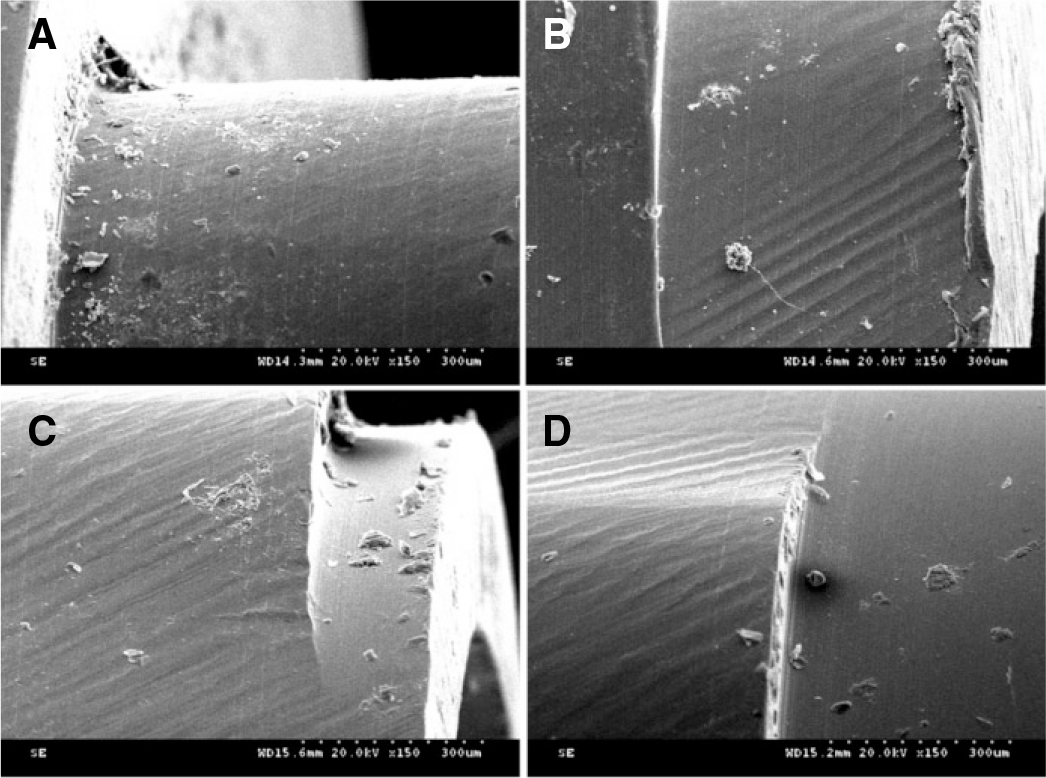
Table 1.
Initial reverse torque value (RTV), post loading RTV, and the difference between the initial and post loading RTVs




 PDF
PDF ePub
ePub Citation
Citation Print
Print


 XML Download
XML Download